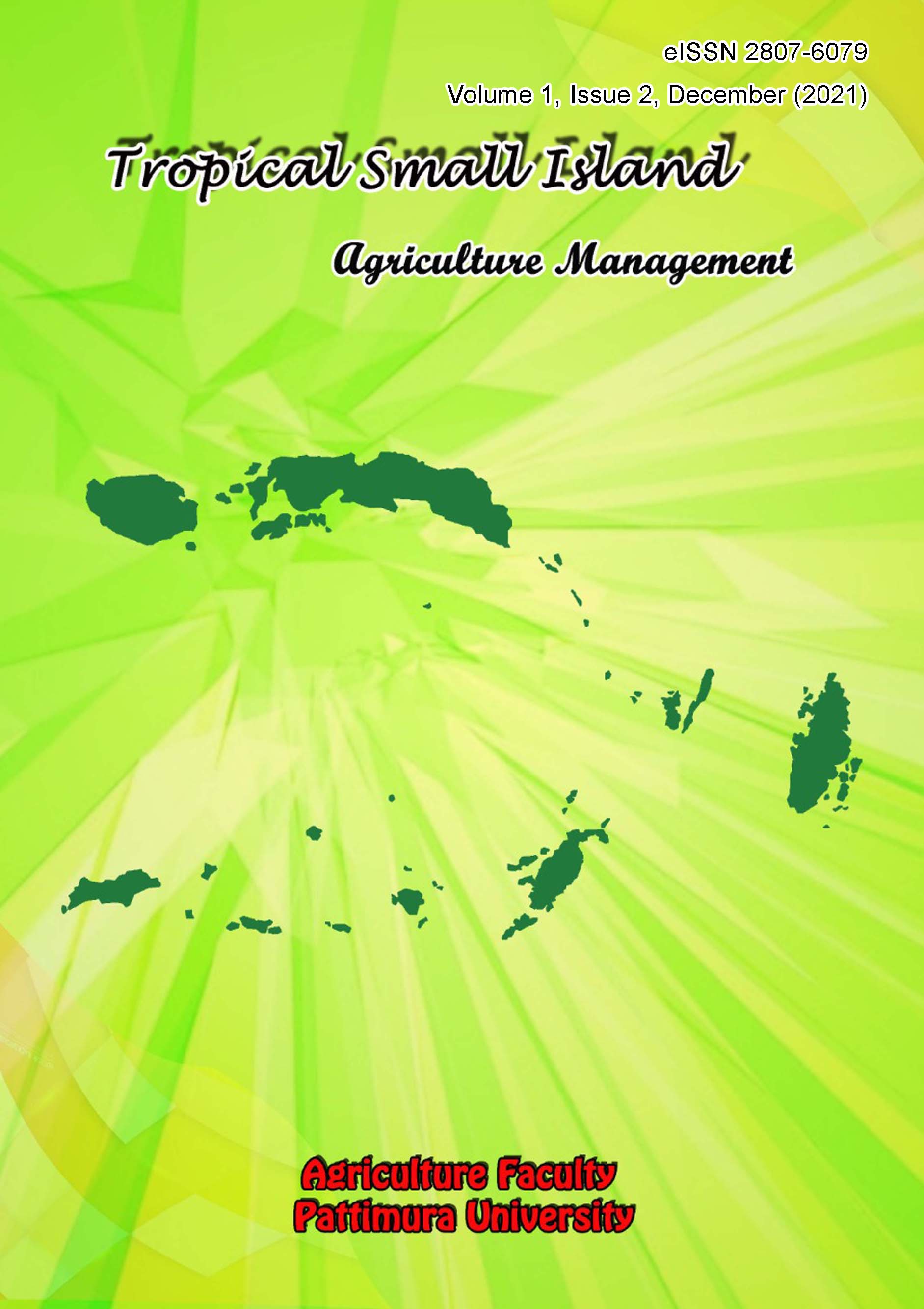System Communication in Management Conflict of Natural Resources Development in Maluku Province
Abstract
Regional conflicts in natural resource management can be caused by the limitations of interested parties in accessing natural resources. This paper aims to provide an overview of the management of natural resource development conflicts through mediation, the actors in natural resource development and to build a communication system model to minimize conflicts. The study concluded that the communication system in managing natural resource development conflicts was done through a mediation process. Mediation facilitates the involvement of conflicting parties and seeks a solution that benefits both parties. The actor is one approach in the structural flow, acting as the state's first or leading actor. As the first actor, the state has two functions: an actor user and protector of natural resources and the environment. The second factor is the entrepreneur (corporate, including mining companies), both at the global and national levels. The third actor in society is the weakest party. This actor almost always understands the process of marginalization or vulnerability to various forms of environmental degradation. The development conflict management communication system aims to change the behaviour of conflicting parties to reduce and resolve conflicts through dialogue and a participatory process
Downloads
References
Annisa L, Satria A, Kinseng, R A. 2009. Konflik Nelayan Di Jawa Timur. Studi Kasus Perubahan Struktur Agraria dan Diferensiasi Kesejahteraan Komunitas Pekebun di Lebak, Banten. Jurnal Sodality Vol. 03, No. 01.
Bawole, R. (2012). Analysis and mapping of stakeholders in traditional use zone within marine protected area. Jurnal Manajemen Hutan Tropika, 18(2), 110-117.
Batlajery, Adrana, August E. Pattiselanno, and Leunard O. Kakisina. "Konflik Agraria di Desa Watmuri Kecamatan Nirunmas Kabupaten Maluku Tenggara Barat." Agrilan: Jurnal Agribisnis Kepulauan 5.2 (2018): 88-100.
Bryant, Bailey. 2001. Third Word Political Ecology. Routledge London and New York.
Dhiaulhaq, A., Gritten, D., De Bruyn, T., Yasmi, Y., Zazali, A., & Silalahi, M. (2014). Transforming conflict in plantations through mediation: Lessons and experiences from Sumatera, Indonesia. Forest Policy and Economics, 41, 22-30.
Fisher S et al. 2001. Mengelola Konflik : Keterampilan dan Strategi Untuk Bertindak. Penerjemah : Kartikasari SN. Jakarta (ID) : The British Council
Freeman RE, Reed DL. 1983. Stockholders dan stakeholders: A new perspective on corporate governance. California Management Review. 25(3): 88-106.
Fuad, F. H., & Maskanah, S. (2000). Inovasi penyelesaian sengketa pengelolaan sumber daya hutan. Lembaga Alam Tropika Indonesia.
Hasyimi M, Rahim Y, Betryon. 2014. Perception of The Effect of Gold Mining Among Stakeholder in Health Sector in Buru District Maluku Province, Year 2012. Jurnal Ekologi Kesehatan.Vol. 13 No 2, 86 – 94.
Ilham. 2006. Analisa Konflik Pengelolaan Sumber Daya Alam Masyarakat Desa Sekitar Hutan. Studi Kasus Masyarakat Desa Curugbitung, Kecamatan Nanggung, Kabupaten Bogor, Propinsi Jawa Barat [Skripsi]. Bogor (ID): Institut Pertanian Bogor.
Leibbrandt, A and Lauri S. 2012. Communication in intergroup conflicts. European Economic Review 56, 1136-1147.
Littlejohn, SW. 2008. Theories of Human Communication. USA : Thomson Wasdworth, USA.
Littlejohn, SW and Kathy Domenici. 2001. Engaging Communication in Conflict : Systemic Practice. London : Sage Publication Inc
Lintong. 2005. Resolusi Konflik Pertambangan di Taman Nasional Bogani Nani Wartabone, Sulawesi Utara [Tesis]. Bogor (ID): Institut Pertanian Bogor.
Malik, S. G., Pieter, N., Sudoyo, H., Kadir, A., & Marzuki, S. (2003). Prevalence of the mitochondrial DNA A1555G mutation in sensorineural deafness patients in island Southeast Asia. Journal of human genetics, 48(9), 480-483.
Marina, I dan Arya HD. 2011. Analisis Konflik Sumberdaya Hutan di Kawasan Konservasi di Indonesia. SODALITY Jurnal. 5(2) : 90-96.
North DC. 1990. Institutions, Institutional Change and Economic Performance. Cambridge (US): Cambridge University Press.
Pakniany, Yamres. Konflik Akses Sumber Daya Alam (Studi Kasus di Kawasan Pertambangan Emas Desa Hila, Kecamatan Kepulauan Romang, Kabupaten Maluku Barat Daya). TESIS. Bogor Agricultural University (IPB).
Pruitt, DG dan Rubin JZ. 2004. Teori Konflik Sosial. Yogyakarta (ID) : Pustaka Pelajar.
Reed MS, Graves A, Dandy N, Posthumus H, Huback K, Morris J, Prell CH, Quin CH, Stringer LC. 2009. Who‟s in and why? A typology of stakeholder analysis methods for natural resources management. J Enviromental Management. 30 (1):1-17.
Ritzer, G dan Goodman, DJ. 2003. Teori Sosiologi Modern. Jakarta: Kencana.
Schoderbek et.all. 1985. Management systems : conseptual considerations. Dallas : Business Publications.
Sangadji, Ismail Munadi, Djuara P. Lubis, and Sofyan Sjaf. "Dinamika Konflik Kepemilikan Lahan Masyarakat Pesisir (Studi Kasus Desa Rohomoni Kecamatan Pulau Haruku Kabupaten Maluku Tengah)." Jurnal Riset Perikanan dan Kelautan 3.2 (2021): 332-346.
Satria, A. (2002). Menuju desentralisasi kelautan. Bogor (ID). IPB Press.
Satria, D. (2009). Strategi pengembangan ekowisata berbasis ekonomi lokal dalam rangka program pengentasan kemiskinan di wilayah Kabupaten Malang. Journal of Indonesian Applied Economics, 3(1).
Tadjudin S. 2000. Manajemen Kolaborasi. Bogor (ID): Pustaka Latin.
Yudhantara. 2006. Konflik Antara BP dengan Komunitas Lokal di Teluk Bintuni Kabupaten Teluk Bintuni Provinsi Irian Jaya Barat [Tesis]. Bogor (ID): Institut Pertanian Bogor.
Wulan, Y. C., Yasmi, Y., Purba, C., & Wollenberg, E. (2004). Analisa konflik: sektor kehutanan di Indonesia 1997-2003. CIFOR.
Copyright (c) 2022 Risyart Alberth Far Far

This work is licensed under a Creative Commons Attribution-ShareAlike 4.0 International License.
Authors who publish with this journal agree to the following terms:
- Authors retain copyright and grant the journal right of first publication with the work simultaneously licensed under a Creative Commons Attribution License that allows others to share the work with an acknowledgment of the work's authorship and initial publication in this journal.
- Authors are able to enter into separate, additional contractual arrangements for the non-exclusive distribution of the journal's published version of the work (e.g., post it to an institutional repository or publish it in a book), with an acknowledgment of its initial publication in this journal.
- Authors are permitted and encouraged to post their work online (e.g., in institutional repositories or on their website) prior to and during the submission process, as it can lead to productive exchanges, as well as earlier and greater citation of published work (See The Effect of Open Access).









